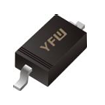Date:2025-05-05 Categories:Product knowledge Hits:439 From:Guangdong Youfeng Microelectronics Co., Ltd
Switching diodes are specialized semiconductor devices designed to operate efficiently in the “on” and “off” states, enabling them to rapidly switch between conducting and non-conducting conditions. Their unique characteristics, such as fast switching speeds, low forward voltage drop, and high reverse breakdown voltage, make them indispensable in a wide range of electronic applications. This article explores the diverse applications of Switching diodes and highlights their significance in modern electronics.
1. Rectification in Power Supplies
One of the fundamental applications of Switching diodes is in power supplies, where they are used for rectification. In an AC-to-DC power conversion process, Switching diodes convert alternating current (AC) input into direct current (DC) output. In a half-wave rectifier circuit, a single switching diode conducts during the positive half-cycle of the AC input, blocking the negative half-cycle, thus producing a pulsating DC output. For a full-wave rectifier, two or more Switching diodes work in tandem to utilize both the positive and negative half-cycles of the AC waveform, resulting in a smoother DC output with reduced ripple. The fast switching speed of these diodes ensures minimal power loss during the rectification process, improving the overall efficiency of the power supply.
2. Signal Processing and Clipping Circuits
Switching diodes play a crucial role in signal processing applications, particularly in clipping circuits. Clipping circuits are used to limit the amplitude of an input signal to a predefined level. For example, in audio processing, a clipping circuit with switching diodes can prevent the output signal from exceeding a certain voltage level, avoiding distortion and protecting the speakers from potential damage. By precisely controlling the forward and reverse biasing of the Switching diodes, the circuit can clip the peaks of the input signal, effectively shaping the waveform. In communication systems, these diodes are also employed in amplitude modulation (AM) and demodulation circuits, where they help extract the original information-carrying signal from the modulated carrier wave.
Previous: Classification, Structure, and Principle of MOSFET